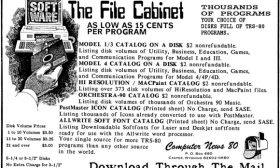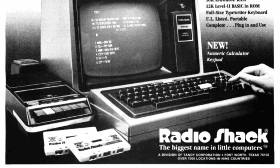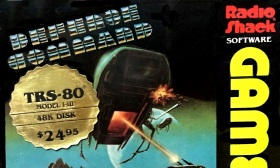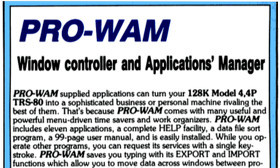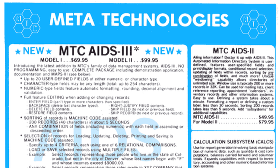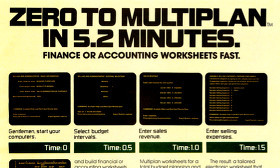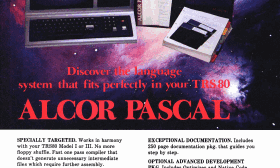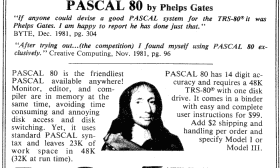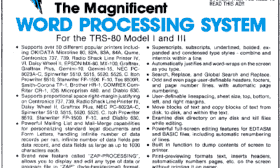Articles in the "Software" Category
ED-IT for the Model 4 is a very powerful text editor for the TRS-80 Model 4. It was written by Mark Reed and was first released on June 17, 1991. ED-IT cost $17.95 and was distributed by Computer News 80 of Casper, Wyoming.
There were many capable editors for the Model 4. Most Z80 assembler packages included their own editors (ALEDIT in ALDS and SAID in MRAS were notable examples). The LS-DOS 6.3 operating system even included a simple text editor named TED/CMD.
But ED-IT contains many useful features for programmers and is suitable for use with multiple programming languages or simple word processing. Despite its many features, it has one of the largest text buffers of any Model 4 editor. As Harold J. Hendriks wrote in the January 1996 issue of Computer News 80:
ED-IT is the CHAMP when it comes to editing large files. It can accept, load and edit ASCII text files up to 47K in size.
(Read more...)
The File Cabinet was the largest collection of TRS-80 public domain and shareware software ever assembled. At its height, it was described as offering “15,000 programs for the Model I/III/4/4P/4D.” Disks from the collection were sold from 1987 to 2009.
The File Cabinet was started in 1987 by Tim Sewell, a sysop of the Tandy RoundTable on the GEnie online service. It began as Sewell’s collection of TRS-80 files submitted to GEnie and that he had downloaded from BBS’s around the country. He described the File Cabinet as a “hobby that I enjoy doing” in the November 1989 issue of Computer News 80:
The File Cabinet was created out of a love for this computer and the chance through magazines who believed in my project to get software into the hands of the people who don’t have access to or use a modem to call BBS systems.
(Read more...)
When the TRS-80 Model I was introduced on August 3, 1977, it came with Level I BASIC, a 4K BASIC interpreter, in ROM. Level I BASIC was created by Steve Leininger, the designer of the TRS-80, who based it on the public domain “Palo Alto Tiny BASIC” that Dr. Li-Chen Wang wrote in 1976.
But Radio Shack’s plan was always to upgrade to a more advanced Model I BASIC later. The very first TRS-80 brochure said that “planned expansion includes an extended Radio Shack Level II BASIC.” It was mentioned again in the first issue of the TRS-80 Microcomputer News (then known as the Radio Shack Microcomputer Newsletter) in 1977:
A Level II BASIC is now being developed. This will be a 12K BASIC with every feature you ever imagined – PEEK and POKE, PRINT USING, transcendental functions, advanced string handling, etc. It should be available on ROM soon.
(Read more...)
Most people considered the Big Five Software games to be the finest games ever written for the TRS-80 Model I and III. They were sold directly through Big Five Software and were resold by many other companies.
Radio Shack also sold Big Five Software games in two collections compiled by Cogito Software. Games Pack Two and Games Pack Three first appeared in the 1984 Radio Shack catalog and contained four Big Five games: Defense Command, Stellar Escort, Cosmic Fighter and Meteor Mission 2. As the packaging stated: “You can look forward to hours of fun for the family, friends, or even the gang at the office.”
Both collections were sold on cassette and self-booting disk. Only minor modifications were made to the games, the biggest being that all copyright messages were changed to “Licensed to Tandy Corporation.
(Read more...)
PRO-WAM (also known as PRO-NTO) is a collection of pop-up tools for LS-DOS/TRSDOS 6 on the TRS-80 Model 4. It was written by Karl Hessinger and Roy Soltoff and cost $59.95 when it was introduced in December 1984.
PRO-WAM was one of the few programs to require a Model 4 expanded to a full 128K of memory. In my opinion, it was one of the best uses of the extra memory and one of my favorite Model 4 utilities.
PRO-WAM was described in advertisements as a “Window Controller and Applications Manager.” It was inspired by the Borland program Sidekick, a terminate and stay resident personal information manager that was very popular at the time on the IBM PC. (PRO-WAM was also similar to Monte’s Window, written by Jim Stutsman, which was only available for Montezuma Micro CP/M.) Like Sidekick, PRO-WAM provided a set of simple, but useful, tools that could be popped up over a running program.
(Read more...)
AIDS-III, also known as MTC AIDS-III, was a very popular database system for the TRS-80 Model I, III, and II. Its unfortunate name (in retrospect) stood for Automated Information Directory System. AIDS-III was a highly regarded program and final member of the family of AIDS products.
Robert Fiorelli, the primary author of AIDS-III, described it not as a “database management system” but as a “data-management system”:
AIDS-III is a data-management system. This is different from a data-base management system. The former is generally faster, more flexible, and is suited for selecting and ordering information in a highly dynamic fashion. By contrast, the latter has higher capacity, is slower and more cumbersome, and is suited for easily accessing individual items of data. Think of it as the difference between driving a station wagon and a bus.
(Read more...)
Microsoft Multiplan was an early spreadsheet program and the first piece of application software from Microsoft to target end users. It was introduced in 1982 with versions for CP/M, MS-DOS, and the Apple II. Versions for many other computers, including various TRS-80 models, soon followed. Multiplan was the first (and for a while the only) third-party software package available when the Apple Macintosh was introduced in 1984.
Multiplan (sometimes called the Multiplan Electronic Worksheet) was a “second generation” spreadsheet, designed to compete with VisiCalc, the original (and incredibly popular) spreadsheet program. Multiplan was written by Douglas Klunder under the direction of Charles Simonyi, the head of Microsoft’s new application software group.
(Read more...)
In the early days of microcomputers, many considered learning Pascal to be the logical next step for beginning programmers after learning BASIC. Alcor Pascal, sold by Alcor Systems of Garland, Texas, was a “complete Jensen and Wirth Standard Pascal” and a popular choice for TRS-80 users who wanted to expand their programming horizons.
In addition to the TRS-80 versions (which cost $199.00), Alcor Systems also sold Alcor Pascal versions for CP/M (including the Apple II with the Microsoft CP/M SoftCard) and later on for MS-DOS computers. Starting in 1983, Radio Shack began selling licensed versions of Alcor Pascal for the Model I/III (catalog number 26-2211) and the Model 4 (catalog number 26-2212). Both versions cost $249.95
Alcor Pascal had its origins in 1978 as a Pascal compiler for CP/M systems, a history that was detailed in the first issue of the Alcor Systems Newsletter in 1982:
(Read more...)
Pascal 80 was a Pascal development system for the TRS-80 Model I, III, and 4. It was written by Phelps Gates, also the author of APL-80, an APL compiler for the TRS-80.
The Pascal 80 package consisted of a full-screen text editor, monitor, and compiler. Pascal source code could be compiled directly to memory or to disk. Editing and compiling Pascal source code in memory made programming Pascal similar to using interpreted languages, such as BASIC. According to the Pascal 80 manual:
Efficient and compact code allows Pascal 80 to have a monitor, editor, and compiler in the computer at the same time, yet leave enough room to create programs up to 23K bytes, with an additional 9K available while the program is running for variables and work space. This allows programs to be written, compiler, edited, and compiled again without time consuming disk access.
When written to disk, resulting programs could either be created as p-code (an intermediate compiled format) or could be merged into standalone /CMD files.
(Read more...)
Zorlof the Magnificent was a powerful word processor for the TRS-80 Model I and III. It was written by Peter Ray and sold by Anitek Software Products of Melbourne, Florida. Released in 1982 for a price of $69.95, Zorlof was often described as a “second-generation word processor,” one generation beyond Electric Pencil and Scripsit.
Zorlof was a full-screen word processor that supported lowercase on the Model I. It provided 61 editing functions, which included common tasks such as deleting lines, global search and replace, and block moves. Word-wrapping and justification were automatically handled by Zorlof. As it stated in the manual:
(Read more...)

